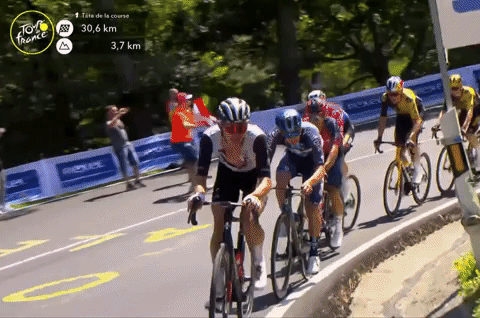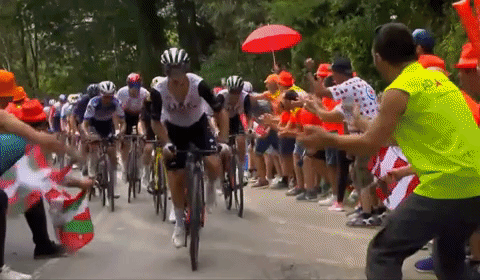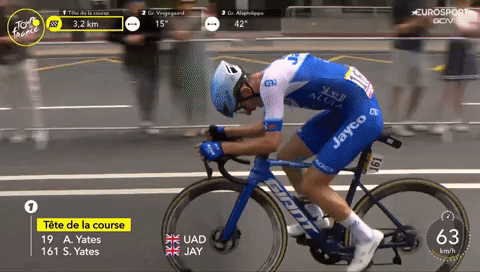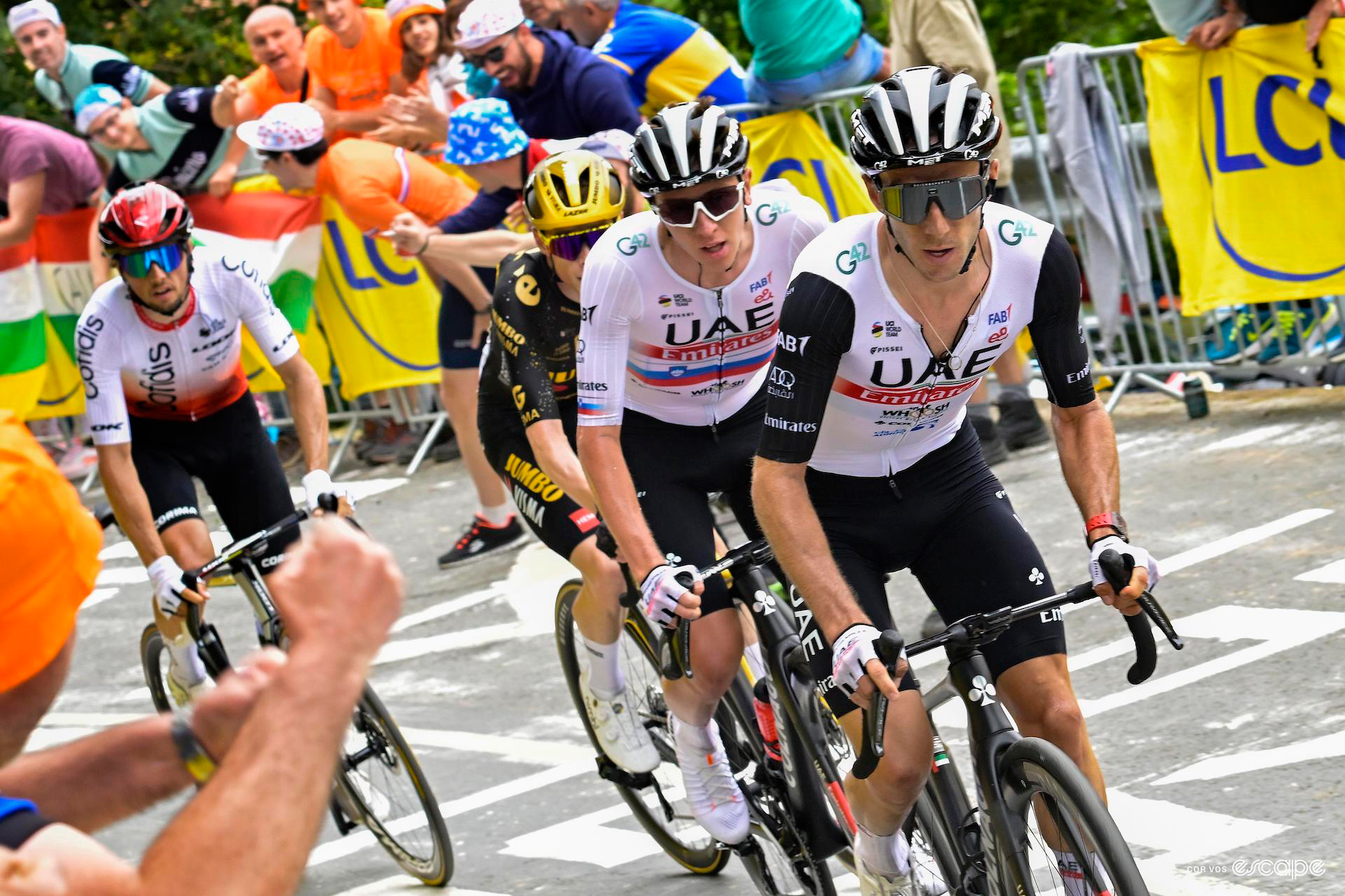The first stage of a Grand Tour is a uniquely complicated thing, and never more so than at the Tour de France. As likely as there being a stage winner is the chance of losing everything, and on stage 1 of the 2023 race Lady Luck had her influence as always. It was a day of mixed fortunes, with Enric Mas and Richard Carapaz suffering a premature departure, while others were simply happy to make it back to Bilbao in one piece.
But for one team, it was absolutely blooming perfect.
An enduring theme of the past few summers has been the comparative strengths of Jumbo-Visma and UAE Team Emirates, the latter always falling short. In 2022, Tadej Pogačar’s support was far stronger than it had been the year before, and they’ve taken another step up in 2023. On the opening stage of this year’s race, the team of the two-time Tour winner proved they’re stronger than ever.
“It’s just an amazing start,” Pogačar said at the finish. He then referred back to the year of his first Tour win: “It reminds me of 2020 when Alex Kristoff [then Pogačar’s teammate] won the first stage, and back then it was a good Tour, so a good start, good end, and I hope it’s the same this year.”
Here are the key moments that culminated in Adam Yates’s stage win, a.k.a. a roll call of UAE’s stellar cast at the start of another Tour de France – like the on-screen credits at the start of a movie.
Bjerg turns the screw
The day’s five-man breakaway was caught before the final trio of categorised climbs, robbing them of the chance to seal the first polkadot jersey of the race, and putting key teams under pressure to prevent further attacks from the peloton. The pace was infernal in the last 50 km, and as the kilometres ticked by, it looked more and more like an early GC day.

While Jumbo-Visma spent much of the stage riding steadily, like the defending champions they are, it was UAE Team Emirates that guided the race into its defining phase on the penultimate climb up the Côte de Vivero (4.3 km at 7%).
Danish TT specialist Mikkel Bjerg laid down the power here, trimming dead weight off the back and forcing Pogačar’s rivals to work, before handing over to Marc Soler for the run-in to the final launchpad.
Accidental attack
Every preview written about this stage listed the Côte de Pike (2 km at 9.8%) as the crucial point of the race, a steep ramp the like of which would look at home at the best of Spring Classics.
Felix Großschartner – who, like Yates, is one of the team’s evidently lucrative new signings – launched first, apparently to set a fierce pace in advance of his leader’s move, but the newly minted Austrian champion’s punch was too big and he found himself off the front.

Victor Campenaerts (Lotto Dstny) attempted to follow but quickly opted to save his matches, and before long, Großschartner himself eased up.
UAE Team Emirates was now firmly in control of proceedings, and next to come to the fore was Adam Yates, Pogačar sliding into his shadow with Jonas Vingegaard as always marking his man.

The Brit’s fluid body language was so controlled and steady that it didn’t seem possible he was going hard enough to drop all but three riders, the top two joined only by Victor Lafay (Cofidis). But drop them he did – although the narrow funnel created by the fans might have had something to do with it – setting Pogačar up for his inevitable attack.

Yates puts Pogačar in credit
Once Pogačar and Vingegaard had been rejoined by their fellow favourites after their first (of surely many) jaunts off the front of the race, the cycling world was treated to a rare sight. In fact, one that many have longed to see for half a decade: Adam Yates vs. Simon Yates.

Naturally, this would never have happened while they were on the same team, but ever since Adam jumped the Australian ship at the end of 2020, there has been a tantalising possibility of a man-to-identical man battle – a showdown like no other.
Alas, until now, the Bury boys have managed to avoid one another in competitive situations, either due to differing form, team roles, or race programme.
So stage 1 was a real treat. Not just twin vs. twin, but Mrs Yates’s lads were alone, so that long-awaited showdown was guaranteed. And who was stronger? The man in the UAE jersey.

And no, I don’t believe it was a gift. It just came down to which Yates had the most punch at the line.
While we’ve been told that Adam Yates carries co-leader status at this Tour (*wink*), we all know what he’s here to do.
“We’re here for Tadej, the boss,” Yates said in his winner’s interview. “He’s shown before he’s the best in the world and over the next three weeks I’m sure he’s going to show that.”
Sure, Pogačar could fall victim to bad luck (again) and be forced out or lose his footing in the GC, in which case Yates will hope to be in a position to take over leadership, but the facts are clear, and the Brit getting a win under his belt strengthens his support role. That is, he’s had his fifteen minutes and will now be more motivated than ever to pay it back.
“Some people doubted having two guys as leaders, but you know, I’m not really a leader,” Yates said, contradicting himself just a touch. “I’m more in support, and when I can do things like this to put other teams under pressure and it works out like this, then it’s perfect. But like I said, over the next three weeks I’m all for Tadej, 100 percent for Tadej, and I’m sure we’ll do a good job.”
Pogačar’s wrist passes the first test
Since breaking his wrist at Liège-Bastogne-Liège, Pogačar’s less than ideal preparation for the Tour gave rise to more questions than he’s faced in recent seasons. But if stage 1 is anything to go on – which it most definitely is – the young Slovenian and his wrist are in fine fettle.
It was first put to the test when Pogačar accelerated over the top of the Côte de Pike, bouncing out of the saddle in an effort intended to punish Vingegaard. Then 10 kilometres later in the GC sprint to the line.

This is not to say that the repeated strain of stage after stage after brutal stage won’t cause a build up of fatigue, but he was by no means held back by weakness. Mind you, even a Pogačar at 95% is on top of the world …

Not mentioned in this story are Matteo Trentin, Vegard Stake Laengen, and Rafał Majka, but they played their role even so. What’s more it’s a long race, and the likes of Majka may well have been under orders to stay incognito for the first week or two, building towards a vital role in the mountains later in the race.
This is a tactic used to full effect by the team’s arch-rivals in Jumbo-Visma at the recent Giro d’Italia. Namely, Sepp Kuss was almost completely invisible until he was needed at the tail end of three weeks. This is perhaps why Vingegaard looked a little isolated at times on stage 1 – Kuss again nowhere to be seen, at least at the pointy end of the bunch – though still better supported than some of his rivals.
Stage 1 confirmed that it’s the two-horse race everyone was anticipating, but with both favourites evidently backed by much more evenly matched teams, this Tour should be a thriller.
Did we do a good job with this story?

